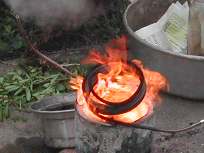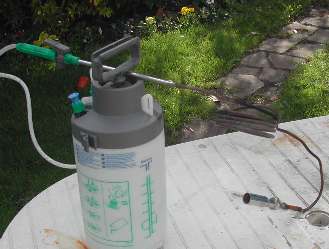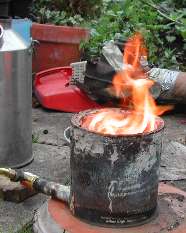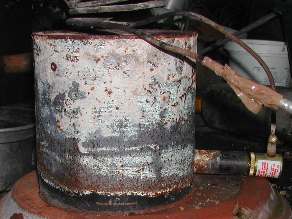USING EXCESS AIR: Experiments With A Steam Aspirator
Andrew J Heggie June 2002
|
Here I post pictures which may help to explain the evolution of what I was trying to do with my steam aspirator. I have had it successfully running but whilst it sustains combustion in a device that self extinguishes in the absence of a fan, it needs much more fettling. In fact the steam content very much modifies the flame, such that I do not think my monotube boiler and nozzle are at all matched to the task. I now think it would probably better suit when used to provide only primary air or as an eductor. In essence I must be achieving very poor mass and power ratios on the aspirator, such that Ken Boak's mechanical propeller could well have better conversion of the steam to air motion. I have also now bought some other tubes with which to demonstrate. Andrew Heggie |
|
| My initial monotube coil (made from ~2.5m of cunifer brake pipe) producing steam in the flame of my small (2.5 litre table top demonstrator) cook stove being powered by a small electric blower. |  |
| Monotube Coil | |
| The same with a view of the pressurised water reservoir and a propane burner nozzle attached. |
 |
| Pressurized Water Reservoir with Burner Nozzle | |
| 6mm coanda nozzle operating on low pressure compressed air prior to being attached to the steam coil. |  |
| 6 mm Coanda Nozzle | |
| The coanda attached and operating on steam, this in fact could never sustain combustion but would operate with steam if a support fan was used to blow into the coanda. In essence the back pressure developed in the coanda plenum was never sufficient to load the steam coil, hence it rapidly filled with condensing water. The coanda is a boundary device and non-linear and I think water droplets were destroying its performance.
In initial trails on the air blown stove but with the coanda in free air it appeared to function well. I think even when steaming well the steam:air ratio was too high and it quenched the flame. |
 |
| A different coil made of a used steel brake pipe which I thought was better as it had a smaller bore, could survive higher temperatures and was easy to attach to by brazing.
The picture actually shows the stove working entirely on the steam aspirator. Even so the losses were great and the flame luminance reduced by the steam that the boiler needed to remain in place for it to work. I did not realise some of the problems with the monotube boiler, I had expected to control pressure via the pump on the reservoir, in fact this does not happen, instead a feedback loop forms and I think the steam flow through the nozzle reaches a stall velocity (speed of sound?). In any case as temperature goes up water consumption falls, the coil pressurises forcing steam out of the nozzle AND back towards the reservoir, as this condenses in the fresh water in the reservoir tube a fresh gulp of water enters the tube and the process restarts. |